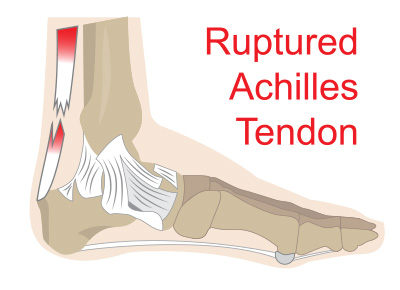
What Is the Achilles Tendon?
A tendon is a band of tissue that connects a muscle to a bone. The Achilles tendon runs down the back of the lower leg and connects the calf muscle to the heel bone. Also called the “heel cord,” the Achilles tendon facilitates walking by helping to raise the heel off the ground.
What is an Achilles Tendon Rupture?
An Achilles tendon rupture is a complete or partial tear that occurs when the tendon is stretched beyond its capacity. Forceful jumping or pivoting, or sudden accelerations or running, can overstretch the tendon and cause a tear. An injury to the tendon can also result from falling or tripping.
Achilles tendon ruptures are most often seen in "weekend warriors." These are typically middle-aged people participating in sports in their spare time. Less commonly, illness or medications, such as steroids or certain antibiotics, can contribute to ruptures.
Symptoms and Symptoms
A person with a ruptured Achilles tendon may experience one or more of the following:
• Sudden pain that feels like a kick or stab in the back of the ankle or calf
• A popping or snapping sensation
• Swelling on the back of the leg
• Difficulty walking, especially uphill
The symptoms require prompt medical attention to prevent further damage. Until the patient sees the doctor, rest, ice, compression, and elevation should be performed.
Diagnosis
In diagnosing Achilles ruptures, the foot and ankle surgeon will often ask questions pertaining to the injury or what occurred preceding injury. It is important to perform a thorough examination, including range of motion and muscle strength testing. In addition, further advanced testing, including MRIs, may be needed.
Treatment
Treatment options for an Achilles tendon rupture are surgical and nonsurgical. The decision as to which is most appropriate is based on the severity of the rupture as well as the overall health and activity of the patient.
Nonsurgical treatment could include casting or protective pneumatic boots depending on the severity of the rupture and health of the patient. Often times there are extensive periods of non-weight bearing and casting with crutches.
Surgical treatment: Achilles tendon ruptures often requires repair of the tendon. There are different surgical techniques available depending on the location of the rupture.






